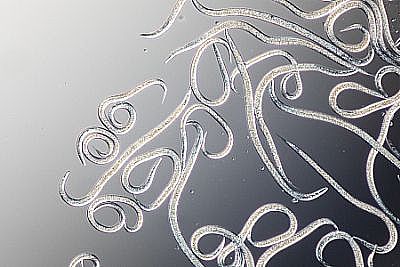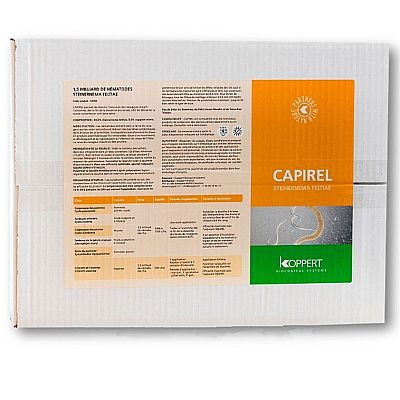CAPIREL / Steinernema feltiae
Target
Larvae of
- Codling moth (Cydia pomonella),
- Oriental fruit moth (Cydia molesta),
- Plum fruit moth (Cydia funebrana),
- Summer fruit tortrix (Adoxophyes orana) and
-
Red-belted clearwing (Synanthedon myopaeformis).Capirel also targets the larvae of the common asparagus beetle (Crioceris asparagi).
Packaging
-
6 bags of 250 million nematodes. Composition of bag 90.5% Steinernema feltiae, 9.5% inert carrier
How does Capirel work
The entomopathogenic nematodes (Steinernema feltiae) parasitize their targets. Nematodes seek out and penetrate their prey, which they kill within 24-48 hours by releasing symbiotic bacteria. When the prey dies, the nematodes feed and grow inside it, after which they hunt for other prey.
How to use Capirel
Application
- Prepare a spray mixture by mixing Capirel with water according to the recommendations on the Technical Data Sheet.
- For the best effect, add an adjuvant.
- Spray the mixture immediately after preparation.
For orchard pests: spray the mixture at the base of scaffold branches, trunks, and on a soil surface of one metre from each side of the row.
For the common asparagus beetle: spray the spray mixture on the foliage and on the whole plant.
When to use Capirel
For orchard pests: in autumn, as soon as the larvae that overwinter in the trunk or on the ground have finished descending. Targeting the overwintering stage reduces inoculum in pests, allowing you to begin with a healthy basis the following season.
For the common asparagus beetle: during cultivation from mid April to mid July, target the larval stages of the first or even second generation.
Best working conditions for Capirel
Ensure that the temperature is between 10 and 30 °C for the first 24 hours following application.
Handling
Biological beneficials have a very short life expectancy and therefore need to be introduced into the crop as soon as possible after receipt. Failure to do so can have a negative impact on their quality. In case you do need to store Capirel, please follow the instructions below.
Storage
- Storage temperature: 2-6 °C
- Store in a dark, dry, and well-ventilated room
- Observe the use-by date shown on the box.
Pesticides can have (in)direct effects on beneficials. Check here





 HellasSITES
HellasSITES